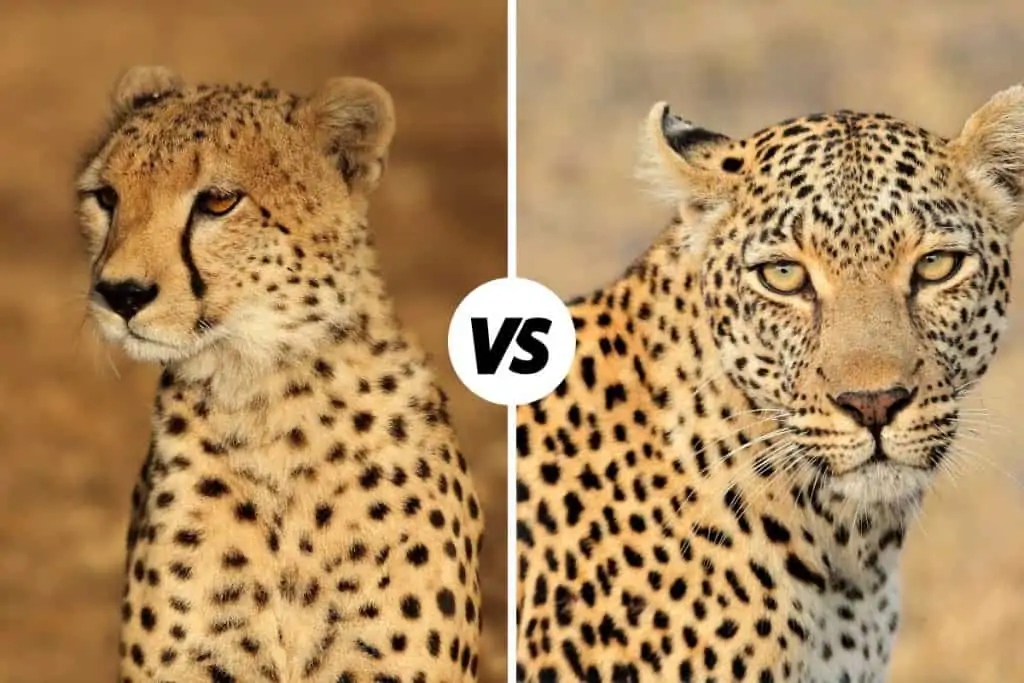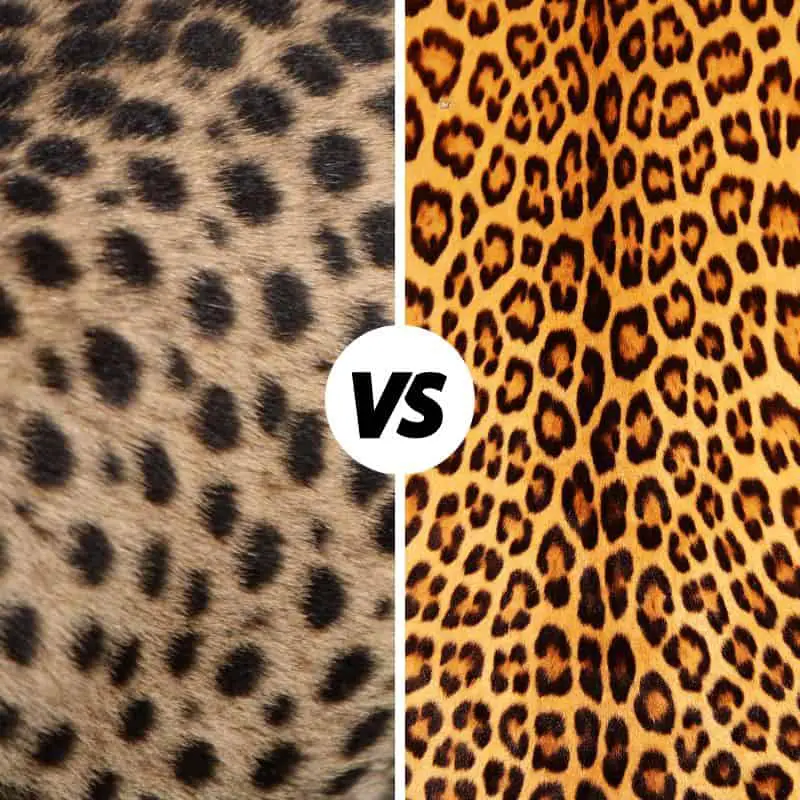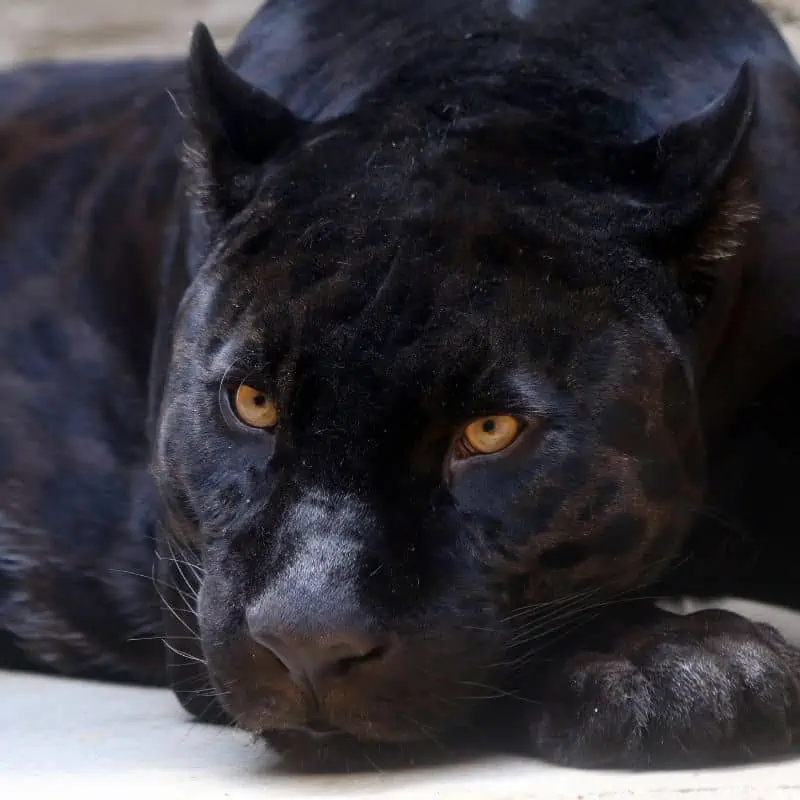There is a lot of confusion between a cheetah vs leopard. This is understandable, as the two animals can seem very similar in appearance, but they’re quite easy to differentiate between.
Cheetahs have round or oval-shaped spots, whereas leopards have rosettes (rose-shaped markings which aren’t spots). Cheetahs have a long and lanky body type, while leopards are strong and muscular. The head of a cheetah is also round, with two black malar stripes, while leopards have a broader head and longer snout.
However, these are only the tip of the iceberg regarding their differences, so let’s dive in further.

What Are The Differences Between Cheetahs And Leopards?
There are several key differences between cheetahs and leopards, some of which we have already mentioned.
Cheetahs are built for speed, while leopards are built for strength. This means cheetahs can run up to 70 mph (112 kph), while leopards can only reach speeds up to 36 mph (60 kph).
Here are the key differences between cheetahs and leopards:
Different Coat Patterns
While they may seem similar at first glance, a cheetah’s coat differs greatly from a leopard’s. Cheetahs have a tawny/creamy coat color with round or oval-shaped spots that are solid black.
Leopards have yellow and tan coats with black rosettes (rose-shaped markings which aren’t spots).
The rosettes on a leopard continue down their tail, while the last third of a cheetah’s tail has black rings.

Very Different Sizes
Cheetahs are slightly taller than leopards but have a much more slender and lanky build. Cheetahs can be as tall as 37 in (94 cm) at shoulder height, whereas leopards top out at around 27.6 in (70 cm) at the shoulder.
When it comes to weight, cheetahs are far lighter and max at around 159 lb (72 kg), whereas leopards can weigh as much as 200 lb (90 kg) thanks to their more muscular build (even though they’re considerably shorter).
While leopards are shorter than cheetahs, their head-and-body length tends to be longer. Leopards have a head-and-body length that can reach 6 ft 5.2 in (196 cm), while cheetahs have a head-and-body length reaching 4 ft 11 in (150 cm).
Add on their tail length, and these are some incredibly large cats. Leopards have a tail length that can reach 3 ft 4.2 in (102 cm), while cheetahs also have a long tail that can reach up to 2 ft 7.5 in (80 cm).
Claws And Teeth
Cheetahs are the only member of the feline family that cannot fully retract their claws. They have claw sheaths in their paws but cannot fully draw them inside.
Leopards have sheaths in their paws, where their claws are firmly tucked away until they need them. Leopards typically use their sharp claws for tree climbing, self-defense, or holding on to prey before neutralizing them with their sharp teeth.
A cheetah uses its claws like cleats on shoes; to provide a better grip on the ground. They also have an oversized dew claw to snag their prey at high speed. During a chase, the cheetah will reach out and trip its prey, often employing the dew claw to its advantage.
Regarding their teeth, cheetahs and leopards have markedly different teeth due to their adaptation. A cheetah will clamp onto its prey’s throat and suffocate it to death. Therefore, they don’t need overly large, or otherwise unique teeth.
On the other hand, Leopards have oversized canines to help them pierce through their prey’s tough hides. They also need them to hold on to their prey as they drag them up into trees and out of the reach of other predators like lions and hyenas.
Leopards will store carcasses up trees so they can return and feed on them later.

A Shared Habitat
While both animals have suffered massive habitat loss, they inhabit similar areas and have shared these common habitats throughout their existence.
Leopards are the wider-reaching of the two species and can be found in forests, savannas, grasslands, deserts, and mountainous regions across Asia and Africa.
These days, wild cheetahs can only be found in central and southern Africa, with a small handfull found in Iran, as well.
Namibia has the largest healthy wild cheetah population, which is not surprising considering the environment is perfect for them, and the country is one of the most sparsely populated in the world.
As these two animals mostly share a habitat and look quite similar, it’s understandable that there can be the odd case of mistaken identity.
Hunting Methods
Cheetahs and leopards have very different hunting methods, one of the main factors that impact their many differences.
Where the cheetah relies on speed to catch its prey, the leopard, on the other hand, pounces and uses brute strength to break its victim’s neck before suffocating them or delivering the final blow.
A leopard uses its forearms and claws to grab and hold onto their prey. A cheetah relies on a quick burst of speed to chase down its prey and hopefully trip them with its front legs.
A cheetah has a rounded head with distinctive tear marks that helps it spot prey on the savanna more easily. A leopard has a broader head with a longer muzzle to tackle larger game.
These big cats also hunt at different times of day, or should I say night. Leopards are typical predators that are nocturnal hunters and often hunt in the late afternoon or the dead of night.
Cheetahs are atypical in this regard, as most big cats hunt at night. Cheetahs hunt in the early morning, between 6 am and 10 am, or in the late afternoon, between 4 pm and 6 pm.
This is most likely due to the lack of other hunters on the open savanna, which ensures the cheetah can keep their prey and not become prey themselves.
Which Lives Longer?
Cheetahs have fairly short life spans, reaching 10 years in the wild or up to 15 years in captivity.
Leopards have a far longer life expectancy (relatively speaking), reaching 12 years in the wild and up to 23 years in captivity.
Mutations
Cheetahs and leopards also have color morphs. This results from a mutation or a recessive gene activated by parents carrying the genetic strain. This is true for both leopards and cheetahs.
The cheetah color morph gives birth to king cheetahs. Although an impressive name, it does nothing to improve the species but make them look more visually stunning.
For leopards, they become melanistic leopards, or the more common term is “black panther.”
This is also the name given to melanistic jaguars.
Unlike the king cheetah, a black panther actually holds a few advantages over its regular leopard relatives. These darker cats have increased immunity to disease and, as you would expect, a heightened ability to hunt in the dark.
It is believed this mutation came about due to a widespread disease among the leopard population that triggered the mutation.

Final Thoughts On The Differences Between Cheetahs And Leopards
While they are both spotted big cats that can reach high speeds, there are several key ways to tell them apart.
Cheetahs have cream-colored coats with darker spots, while leopards tend to be yellow or tan with black rosettes. Cheetahs also have tall, slender bodies and can’t fully retract their claws – giving them an advantage when running but making it more difficult for them to climb trees as leopards do.
Finally, leopards tend to be nocturnal hunters, while cheetahs prefer early morning or afternoon hours.
Now that you know some of the key differences between these two wild animals, see if you can spot a cheetah next time you’re on safari.
